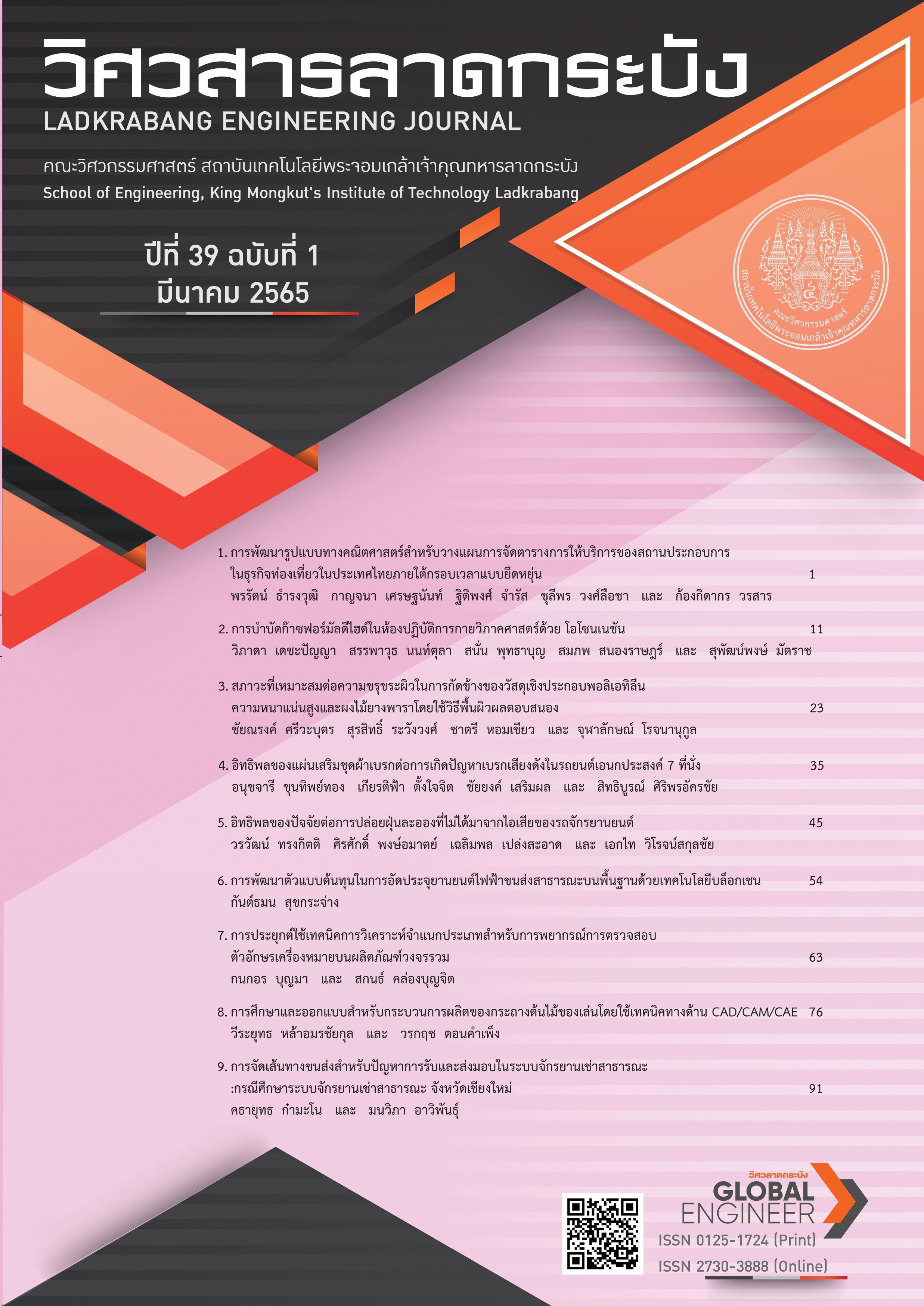Treatment of Gaseous Formaldehyde in a Gross Anatomy Laboratory using Ozonation
Keywords:
Gaseous formaldehyde, Ozonation, Gross Anatomy Laboratory (GAL), Toxic gas treatmentAbstract
The main objective of this research was to study treatment of gaseous formaldehyde in a Gross Anatomy Laboratory (GAL) using the prototype of toxic gas purifier with ozonation. Factors affecting treatment removal efficiency include ozone dosage rate and air blower speed. Response Surface Methodology (RSM) with the Central Composite Design (CCD) model was applied to design the experimental sets and to analyze the statistical data. The optimal conditions for treatment of gaseous formaldehyde were also investigated. Two sets of experiment were conducted in which, the first set was for case study 1 (the cadaver studied by medical students) and the second set was for case study 2 (The cadaver studied by nursing students). Results show that formaldehyde removal efficiencies received from most of experiments were relatively high (above 85%) for both case studies. Predicted removal efficiencies from the mathematical model were in good agreement with those from experimental data. The optimal conditions obtained from the CCD model were at the ozone dosage rate of 1,210 mg/hr and the air blower speed of 1.24 m/s.
References
The United States Environmental Protection Agency (US.EPA.). “Facts About Formaldehyde.” epa.gov. https://www.epa.gov/formaldehyde/facts-about-formal dehyde#whatisformaldehyde. (accessed: Jul 5, 2021)
S. Dangruang, “The study of health impact assessment of workers from formaldehyde exposure, melamine faced board processing industry case study,” Master dissertation, Dept. Envi. Sci., Silpakorn Univ., Bangkok, Thailand, 2011.
Ocupational Safety and Health Administration (OHSA.). “OSHA Fact Sheet, Formaldehyde.” odu.edu https://www.odu.edu/content/dam/odu/offices/environmental-health-safety/docs/formaldehyde.pdf. (accessed: Jun 29, 2021)
C. H. Tseng, C. D. Hsieh and S. S. Chen, “The Removal of Indoor Formaldehyde by Various Air Cleaners,” in Proc. the 98th A&WMA Annual Conf. Minneapolis, MN, USA, June 21–24, 2005, pp. 457–469.
W. Dechapanya, W and S. Nontula, “Treatment of Gaseous Formaldehyde with Continuous Source in a Closed Modeling Room Using Ozonation,” Thai Environmental Engineering Journal, vol. 31, no. 1, p. 37–43, 2017.
F. Wang, H. Sun, J. Sun, X. Jia, Y. Zhang, Y. Tang, X. Pan, Z. Su, L. Hao and R. Wang, “Mechanistic and Kinetic Study of CH2O+O3 Reaction,” The Journal of Physical Chem. A, vol. 114, no. 10, p. 3516–3522, 2010, doi: 10.1021/jp910754b.
J. W. Li, K. L. Pan, S. J. Yu, S. Y. Yan and M. B. Chang, “Removal of Formaldehyde over MnxCe1-xO2 Catalysts: Thermal Catalytic Oxidation versus Ozone Catalytic Oxidation,” Journal of Environmental Sciences, vol. 26, no. 12, p. 2546–2553, 2014, doi: 10.1016/j.jes.2014.05.030.
C. J. Weschler, “Ozone in Indoor Environments: Concentration and Chemistry,” Indoor Air, vol. 10, p. 269-288, 2000, doi: 10.1034/j.1600-0668.2000.010004269.x
W. Dechapanya, W, S. Nontula and Phudthabun, S. “Design and Creation of Prototype Reactor for Treatment of Formaldehyde in a Gross Anatomy Laboratory,” in Proc. the 19th National Environmental Conf. Chiang Rai, Thailand, October 7–9, 2020, pp. 328–335.
A. Chanpirak, P. Dumnin and A. Hongpuay, “Optimization of Oil Extraction from Spent Coffee Grounds (Coffea canephora var. robusta/Coffea Arabica) by Hexane Using Response Surface Methodology,” The Journal of KMUTNB. vol. 28, no. 4, p. 799–811, 2018.
M. Kim, E. Park and J. Jurng, “Oxidation of Gaseous Formaldehyde with Ozone over MnOx/TiO2 catalysts at Room Temperature (25°C),” Powder Technology, vol. 325, p. 368–372, 2018, doi: 10.1016/j.powtec.2017.10.031.
S. W. Cheng, Y. H. Li, C. S. Yuan, P. Y. Tsai, H. Z. Shen and C. H. Hung, “An Innovative Advanced Oxidation Technology for Effective Decomposition of Formaldehyde by Combining Iron Modified Nano-TiO2 (Fe/TiO2) Photocatalytic Degradation with Ozone Oxidation.” Aerosol and Air Quality Research, vol. 18, p. 3220–3233, 2018, doi: 10.4209/aaqr.2018.05.0156.
J. Wilamat, N. Bunchudam, and A. Jaicoey, “Removal of Formaldehyde in Air using Silver-Doped TiO2 Coated on Stainless Steel Wire under Fluorescent Light,” A Special Project, Faculty of Science, KMITL, Bangkok, Thailand, 2017.
W. Liang, J. Li and Y. Jin, “Photo-catalytic Degradation of Gaseous Formaldehyde by TiO2/UV, Ag/TiO2/UV and Ce/TiO2/UV.” Building and Environment, vol. 51, p. 345–350, 2012, doi: 10.1016/j.buildenv.2011.12.007
Downloads
Published
How to Cite
Issue
Section
License
Copyright (c) 2022 Faculty of Engineering, King Mongkut’s Institute of Technology Ladkrabang

This work is licensed under a Creative Commons Attribution-NonCommercial-NoDerivatives 4.0 International License.
The published articles are copyrighted by the School of Engineering, King Mongkut's Institute of Technology Ladkrabang.
The statements contained in each article in this academic journal are the personal opinions of each author and are not related to King Mongkut's Institute of Technology Ladkrabang and other faculty members in the institute.
Responsibility for all elements of each article belongs to each author; If there are any mistakes, each author is solely responsible for his own articles.






